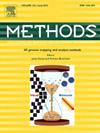优化的CUT&Tag能够在裂糖菌pombe中实现稳健的表观基因组分析
IF 4.3
3区 生物学
Q1 BIOCHEMICAL RESEARCH METHODS
引用次数: 0
摘要
我们优化了S. pombe中CUT&;Tag的渗透性,使用轻度固定的渗透性磷脂质体实现稳健的H3K9me3分析,克服了ChIP-seq的局限性,包括交联伪影和高细胞输入。我们建立了一个优化的切割靶下和标记(CUT&Tag)方案,用于高分辨率的裂糖酵母表观基因组分析,使用临界渗透细化鉴定出Lywallzyme是球质体生成的最佳酶(在10 mg/mL条件下60分钟效率为95%),优于酶解酶- 20t和组合处理。系统参数优化揭示了浓度依赖的消化动力学和反向的细胞负载效率关系(5 × 105个细胞在5 mg/mL的条件下在50分钟内达到90%的转化率)。通过在野生型和clr4Δ菌株(10 26个细胞/重复)中进行H3K9me3定位验证,该方法在突变体中捕获了着丝粒/端粒的特异性异染色质富集,信号完全消失,同时减少了DNA尖峰(0.2 pg),显著提高了信噪比。该方案能够以最小的细胞输入和增强的分辨率进行稳健的表观基因组分析。本文章由计算机程序翻译,如有差异,请以英文原文为准。
Optimized CUT&Tag enables robust epigenome profiling in Schizosaccharomyces pombe
We optimized permeabilization for CUT&Tag in S. pombe, enabling robust H3K9me3 profiling using lightly fixed permeabilized sepheroplasts, overcoming limitations of ChIP-seq including crosslinking artifacts and high cell input. We established an optimized Cleavage Under Targets and Tagmentation (CUT&Tag) protocol for high-resolution epigenome profiling in Schizosaccharomyces pombe using Critical permeabilization refinements identified Lywallzyme as the optimal enzyme for spheroplast generation (>95 % efficiency in 60 min at 10 mg/mL), outperforming Zymolyase-20 T and combinatorial treatments. Systematic parameter optimization revealed concentration-dependent digestion kinetics and an inverse cell load-efficiency relationship (5 × 105 cells achieving > 90 % conversion in 50 min at 5 mg/mL). Validated through H3K9me3 mapping in wild-type and clr4Δ strains (10⁶ cells/replicate), this approach captured specific heterochromatic enrichment at centromeres/telomeres with complete signal ablation in mutants, while reduced spike-in DNA (0.2 pg) significantly enhanced signal-to-noise ratios. The protocol enables robust epigenomic analysis with minimal cell input and enhanced resolution.
求助全文
通过发布文献求助,成功后即可免费获取论文全文。
去求助
来源期刊

Methods
生物-生化研究方法
CiteScore
9.80
自引率
2.10%
发文量
222
审稿时长
11.3 weeks
期刊介绍:
Methods focuses on rapidly developing techniques in the experimental biological and medical sciences.
Each topical issue, organized by a guest editor who is an expert in the area covered, consists solely of invited quality articles by specialist authors, many of them reviews. Issues are devoted to specific technical approaches with emphasis on clear detailed descriptions of protocols that allow them to be reproduced easily. The background information provided enables researchers to understand the principles underlying the methods; other helpful sections include comparisons of alternative methods giving the advantages and disadvantages of particular methods, guidance on avoiding potential pitfalls, and suggestions for troubleshooting.
 求助内容:
求助内容: 应助结果提醒方式:
应助结果提醒方式:


